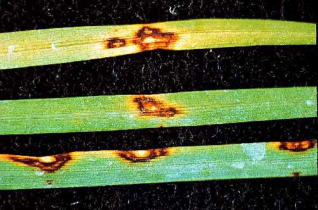
Leaf Spot



Ultralawn Incorporated
1055 East 260th Street
Euclid, OH 44132
216.731.7756
440.951.3738
Office hours Monday-Friday 9-3 call today with any questions

Symptoms: Leaf spots on turf grass leaf blades begin as small red
to purplish ovals that later develop tan centers of dead tissue with
darker borders. The fungi that cause leaf spots directly penetrate
leaf sheaths and blades at random or enter through mowing
wounds, which commonly leads to a tip blight. When turf grass is
succulent from recent nitrogen fertilization and there is abundant
moisture on the leaf blades, numerous leaf spot infections per
blade can occur. The leaf spots may then combine and cause
extensive blighting. The fungus may even invade the crowns and
roots, leaving the plants weakened and rotted. This severe stage is
called "melting-out." Large areas of dead or badly weakened turf
grass may result.
Season: Leaf spot fungi may be active at a variety of
temperatures. All are associated with frequent moisture on the leaf blades and high relative humidity.
•
Leaf spots caused by the fungi Drechslera poae and Drechslera sic-cans are almost always present in
lawns. Repeated infection and expansion of leaf spots to blights may lead to "melting out," which is
extremely common in Kentucky bluegrass and perennial ryegrass in early summer. Extensively infected
plants may die, especially when stressed in hot summer weather.
•
Summer: Another species of fungus, Bipolaris sorokiniana, attacks nearly all turf grass species and is most
aggressive at high (over 85 degrees F) temperatures and relative humidity. It may lead to crown and root
rots.
•
Fall: The same fungi that are active in spring may cause leaf spots again in fall during rainy weather.
Usually disease is not as severe as in spring, but heavy spore production in fall will increase disease
potential for the following spring.
Disease Cycle: The fungi that cause leaf spots and “melting-out” have simple life cycles. Spores exposed to
moisture on leaf blades for a few hours germinate and infect the turf grass. The fungus penetrates the leaf
tissue, killing cells and absorbing nutrients. Further spores are produced on diseased tissue only a few days
after the initial infection. Spore production is prolific on mowing clippings. In addition to the species listed
above, several other fungi from these two genera cause various leaf spots and blights, which occur on other
common lawn turf grass species. Their life cycles are essentially identical to those already mentioned. Several
fungi from the genera Ascochyta, Leptosphaerulina and Septoria cause, predominantly, tip and leaf blights in
prolonged wet weather. They can usually be identified by the presence of small black dots (fruiting bodies filled
with spores) in dead leaf tissue. They infect the leaf blades, giving the lawn a ragged appearance, but are not
known to invade the crowns and roots. Leaf spot and tip blight fungi are present in every established lawn.
They only cause serious damage during extreme weather conditions involving frequent wetness or when
improper lawn care practices aggravate the disease problem. The actual identification of the fungus that is
causing a leaf spot is usually not necessary because the cultural and chemical controls described below are
effective against all species.
Cultural Management: Keep in mind that mowing increases infection by leaf spot fungi in the following ways:
•
Wounds are made that allow easy penetration by the fungi, especially when dull mower blades shred the
leaf blades.
•
New spores are produced in abundance on returned mowing clippings when leaf spots are present.
•
Mowers and footsteps also will spread spores. If only scattered leaf spot is observed, no significant harm
should come to the lawn. Severe damage is the result of repeated infection of stressed plants.
These practices should limit disease to an acceptable level:
•
Avoid excessive early spring nitrogen applications with water-soluble fertilizers. The resulting lush growth
is very susceptible to infection by leaf spot fungi.
•
Water infrequently and deeply. Keep leaf blades dry as long as possible. Never water in the late afternoon
or early evening. Avoid frequent light sprinklings.
•
Mow high to avoid plant stress. Mow frequently and only cut 1/3 of the blade at a time. Collect clippings
when numerous leaf spots are observed to reduce spore production. Do not mow when grass is wet.
Chemical Management: Fungicides should not be applied routinely for leaf spot. If cultural management has
not prevented severe infection or if prolonged wet weather occurs, a contact fungicide is available. Turf grass
suffering from severe "melting-out" or crown and root rot will not be improved by fungicide applications.

Close up of Leaf Spot lesions


















